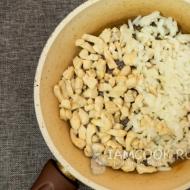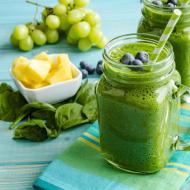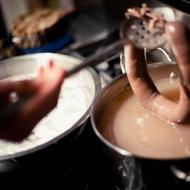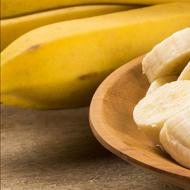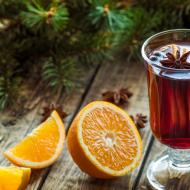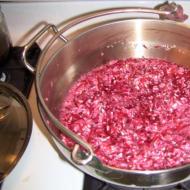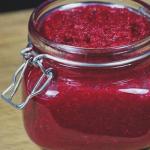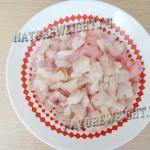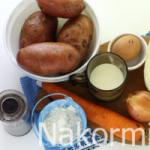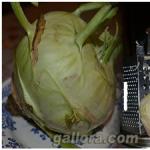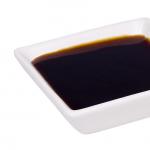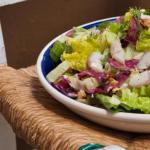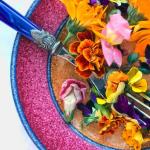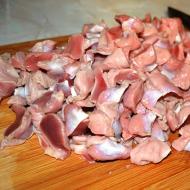
Blackcurrant jelly for the winter quickly. Blackcurrant jelly for the winter without gelatin. Step-by-step instructions for a cold-cooked jelly recipe from currants for the winter
The other day I made jam or jelly. And I thought, what is the difference between them? I got on the Internet. Here's what I found. Jam is made by boiling whole berries or their pulp (even vegetables) with sugar. When frozen, it is a fairly dense consistency with pieces of fruit. Jelly is obtained by boiling berry juice with sugar to a dense mass without fruit pieces.
Well, then, I was engaged in the preparation of blackcurrant jelly. I don’t know if it will last me until the winter, it turned out to be painfully tasty. But nothing, the bushes are still full of berries - I'll cook the second batch.
Blackcurrant in its composition has a large amount of pectin, so it freezes very well. In winter, you can not only eat with spoons and drink tea, but also use it as a spread on bread, bake in pies. It is also great for making confit, which is used in cakes.
Preservation methods are different - from five minutes to cooking in the usual way. But all recipes are quite simple to prepare. In my opinion, the berry has enough pectin of its own, but if you want to get a quick and hard jelly, adding gelatin, pectin or agar-agar will do. And do not forget about recipes and.
I used these recipes at the very beginning of my culinary career. Then she dropped it. Now I remembered again and cooked. I had few berries, because. daughter came and ate half a cup just like that. So it only took me an hour to prepare.
Products:
- Black currant - 700 g
- Sugar - 500 g

- I prefer to do without water, because the berries already have plenty of it. This time I collected large fruits from the bushes, the size of a good gooseberry. Quite sweet in taste. Washed and sent to the pan on the fire (slightly above average).

- Be sure to stir otherwise it will burn. I wait until it gurgles and until foam appears, I turn off the burner, and pierce the contents with an immersion blender.

- Immediately, I rub the hot mass through a sieve, removing grains and peel. I cool and freeze the cake - an excellent preparation for jelly and fruit drink.
- Tried to use gauze, uncomfortable. It kicks in almost immediately. And you have to wash it constantly. In addition, gloves are needed in this case, otherwise it is difficult to wash your hands.

- As a result, I got 500 g of juice. I added 500 g of sugar to them. The result was a proportion: for 1 liter of juice - 1 kg of sugar.

- Brought to a boil. Then she reduced the heat and cooked for 20 minutes, removing the foam and stirring.
- The jars were sterilized in the microwave, the lids were doused with boiling water and drained.

- As a result, she poured the hot mass into hot jars. Didn't cover with lids. Let it cool down. The cooled mass when turning over the cans does not flow out. The texture is dense and unified. Then she closed the lids.
- I didn’t put it away for storage - fresh is eaten immediately. For use in winter, you will have to make another portion of a larger size.
Jelly jam 5 minutes blackcurrant (3-6-9)
Strange numbers 3-6-9 you say. What do they mean? Just the proportions of water, berries and sugar. Or in other words, 1-2-3. The recipe is very simple, since the proportions are already indicated, and it is cooked for only five minutes. And besides, it is easy and quick to do without scales, and measure with glasses, cups or jars.
Prepare:
- Water - 1 tbsp.
- Berries - 2 tbsp.
- Sugar - 3 tbsp.
Cooking:
- Dissolve sugar in water by heating.
- Bring the syrup to a boil and dip the berries into it.
- Once again, make the whole mass boil. Boil it for five minutes, removing the foam and stirring occasionally.
- Turn off the stove, pour into prepared jars. It is better to close with plastic caps and only after complete cooling.
- Due to the short cooking time, a beautiful color and amazing aroma remain.
Thick blackcurrant jam-jelly for 11 glasses
Ordinary glasses are in any family, although they are now rarely used. But when it comes to measuring ingredients, they do an excellent job. The jam is very thick, hardens like jelly. The main thing is to strictly observe the proportions.
- Currant berries - 11 tbsp.
- Sugar - 13 tbsp.
- Water - 1.5 tbsp.
Cooking:
- Sort the berries, free from debris and twigs. Rinse, dry.
- Place the berries in a large container, walk over them with a pusher and pour water.
- Put on fire and gradually add sugar, measuring the right amount.
- When the sand is completely dissolved, bring the mass to a boil and boil over low heat for 10 minutes.
- Then pour into clean jars, cool, and then close the lids.

Blackcurrant juice jelly without cooking and gelatin
Blackcurrant contains a huge amount of natural thickener, and it is not necessary to add gelatin to get a thick jelly-like mass.
You will need:
- Berries - 500 g
- Sugar - 1000 g
Cooking:
- We wash the berries. To facilitate the work, we will go through them with a pusher, and then pass through a sieve in portions, separating the juice from the cake.
- Pour a little sugar into blackcurrant juice and dissolve it. We do this until it ends. Can be left overnight.
- After dissolution, fill clean jars with jelly mass. Let's cork.

Gooseberry and blackcurrant jelly
Since the berries ripen at the same time, why not make an assortment of them. Gooseberries will soften the pronounced taste of currants.
Products:
- Black currant - 1 kg
- Gooseberries of any color - 2 kg
- Sugar - 1.5 kg
- Water - 1 tbsp.
Cooking:
- We wash the berries and put them in a bowl.
- Fill with water and put on fire. We are waiting for the berries to burst.
- Then we will go through them with a blender or pusher.
- Squeeze the juice from the hot mass through a sieve.
- Now boil the juice with sugar based on 1 kg of juice - 1 kg of sand for 15-20 minutes. Let's break it down into jars.
- Cover with a towel or gauze until the next day. When it cools down, you can turn the jar upside down - the mass will not flow out, it has frozen. Close the lids and store.
The recipes are simple and quick to make. The result is a fragrant, thick mass of beautiful color. Suitable to spread on a long loaf, and even better bake an open pie with blackcurrant jelly.
Blackcurrant is a berry that is not particularly whimsical and easily accessible in our latitudes. Its plentiful harvests often take the owners of summer cottages by surprise: you can’t eat a lot of fresh blackcurrants, fruit drinks also quickly get bored ... There is only one option left - to make a blank out of it for the winter. And if everything is simple with freezing berries, then recipes for jams and jams can pose a difficult choice, because there are many options for currant delicacy. Take at least one of the most successful and popular options - blackcurrant jelly (recipe for the winter). This most delicate berry yummy can be prepared without cooking (cold method), with gelatin or with the addition of other berries. Currant jelly is also delicious according to quick five-minute recipes, which are also plentiful on the network. You will find the best recipes for making blackcurrant jelly with photos and videos with step-by-step instructions for winter preparations later in our article.
Blackcurrant jelly with gelatin for the winter - a step by step recipe with a photo
It may seem that the process of making blackcurrant jelly with gelatin for the winter from the step-by-step recipe with the photo below is more like boiling classic jam. But there is one little trick, thanks to which the consistency of this currant delicacy turns out to be exactly jelly-like. It is easy to guess from the name that the wonderful transformation of blackcurrant jam into jelly for the winter is due to the addition of gelatin. You can also use agar-agar or pectin instead.

Necessary ingredients for blackcurrant jelly with gelatin for the winter
- fresh blackcurrant -0.5 kg
- sugar - 0.5 kg
- water - 250 ml
- lemon juice - 2 tsp
- gelatin - 15 gr.
Step-by-step instructions for a recipe for jelly with blackcurrant and gelatin for the winter

Delicious jelly for the winter from black and red currants - a simple step-by-step recipe
This version of delicious jelly for the winter is prepared from two varieties of currants - red and black. This recipe is especially relevant if there are a few different berries left after spinning the main part of the currant crop. How to cook delicious jelly for the winter from red and black currants, read the simple step-by-step recipe below.

Necessary ingredients for a delicious jelly for the winter from black and red currants
- red currant - 1 kg
- blackcurrant - 1 kg
- sugar - 0.6 kg
Step-by-step instructions for a simple recipe for winter jelly with black and red currants
- We start by washing the berries. To do this, we combine both varieties together and rinse thoroughly, remove the twigs and stalks. We recline in a colander and wait for the excess water to drain.
- Pour currants prepared in this way with cold water so that it completely covers the berries. We put on fire and begin to cook, stirring from time to time.
- When the berries begin to secrete juice (the color of the water becomes intense), remove from the stove and filter the liquid. We throw the boiled berries on gauze and squeeze out the juice, which we add to the main liquid. Leave for a day under the lid.
- The next day, put the currant juice to cook on a slow fire. Our task is to boil it by about half.
- While stirring, add sugar, and continue to cook until cooked - the syrup should become thick.
- Pour hot currant jelly into sterile jars and twist the lids. Ready!
Simple blackcurrant jelly for the winter - step by step instructions
As practice shows, the simpler the recipe, the more popular the dish. With regard to the following simple preparation of blackcurrant jelly for the winter with step-by-step instructions, this rule works unquestioningly. It is based on only two ingredients - currant juice and sugar. How to make simple blackcurrant jelly for the winter in the step-by-step instructions below.

Essential Ingredients for Simple Blackcurrant Jelly for the Winter
- currant - 1 kg
- sugar - 600 gr.
Step-by-step instructions for a simple blackcurrant jelly recipe for winter
- We clean the washed currants from dry stalks and dry them slightly on a towel.
- Using a blender, grind the currants until a puree is formed. Gently transfer the mass to gauze folded in 3-4 layers and squeeze the juice.
On a note! If the currant mass is very thick and difficult to squeeze out, you can add 100 ml of warm water and mix. Such diluted currants will give juice much easier.
- We dilute the finished juice with water in a ratio of 2: 1 and put it on the stove to cook. After boiling, reduce the heat and continue to reduce the juice by half.
- Take the pan off the stove and add sugar. Stir until sugar is completely dissolved. Immediately pour the hot syrup into sterile jars and seal. After complete cooling under a warm blanket, we transfer the jars to storage in a cool place.
Quick blackcurrant jelly without cooking for the winter - step by step recipe
Do you want the fastest and easiest recipe for making delicious and most importantly mega-useful blackcurrant jelly without cooking for the winter? Then immediately adopt the following recipe. Despite the fact that quick blackcurrant jelly is prepared for the winter without cooking, it turns out to be very thick and is stored for a long time.

Necessary ingredients for quick no-boil blackcurrant jelly for the winter
- black currant -1 kg
- sugar - 1.5 kg
Step-by-step instructions for quick no-boil blackcurrant jelly for winter
- So, my currants and sort out. We cut off all dry inflorescences with scissors. Lay out on a towel and dry.
- In small portions, we pass the currant through an electric meat grinder once. If you have a regular meat grinder, then it is better to skip the berries twice. You can also grind the berries with an immersion blender.
- The resulting mass with juice should be covered with sugar and mix well, leave for an hour. After this time, mix the berry mass well again and make sure that all the granulated sugar is completely dissolved.
- We shift the mass into clean and always sterile jars. Pour 1-2 centimeters of sugar on top to form a sugar cork that protects against mold. You can also cut a circle out of paper and soak it in alcohol, and then put the jelly under the lid when it has dried.
- It is not necessary to turn currant jelly for the winter after blockage, just transfer it to a cool place.
A simple cold blackcurrant jelly recipe for the winter, step by step
Since there is a lot of pectin in blackcurrant, jelly is often made from it for the winter in a cold way according to a fairly simple recipe. In order for such currant jelly to thicken and acquire the correct consistency, it is necessary to hold it for a week - the second in the sun. All the details of cooking in a simple recipe for blackcurrant jelly in a cold way for the winter are below.

Essential Ingredients for an Easy Cold-Make Blackcurrant Jelly Recipe for Winter
- currant juice - 2 cups
- granulated sugar - 600 gr.
Step-by-step instructions for a cold-cooked jelly recipe from currants for the winter
- First, the procedure is standard: we sort out the currants, remove the excess and wash. Dry on a paper towel folded in several layers.
- Then you need to extract the juice from the berries. You can, for example, skip currants several times through a meat grinder and squeeze through gauze, use a juicer or blender. You can also crush the berries with a regular mashed potatoes.
- Pour the prepared currant juice into a deep container and pour sugar in small portions. Stir until all the granulated sugar is completely dissolved in the juice.
- After that, you need to pour the currant syrup into sterile jars, and cover with paper on top and tie tightly with a thread.
Important! For this recipe, jelly jars should only be dry-sterilized in the oven or microwave. Sterilization with boiling water leaves moisture on the glass, which can lead to mold later on.
- We put jars of currant jelly on a sunny windowsill and leave for 1-2 weeks. Thanks to the sun, the delicacy will acquire its jelly-like consistency. After we store the jelly in the refrigerator.
How to cook quick blackcurrant jelly "Five Minute", a recipe for the winter with a video
Another option on how to cook delicious and quick blackcurrant jelly (recipe for the winter "Five Minute") will be found in the next video. And although gelatin is not needed to make it, currant jelly is as thick as cold-cooked or raw jelly without cooking. Detailed step-by-step instructions on how to make a quick five-minute blackcurrant jelly in the video recipe for the winter below.
Blackcurrant jelly for breakfast teaBlackcurrant is a strikingly fragrant berry with a slight sour taste, it is the most valuable source of vitamins that are so necessary for the human body, especially for growing ones. But these very growing organisms do not really want to consume this wonderful berry, turning up their noses from it. So my precious daughters do not want to replenish their bodies with natural vitamins that live in blackcurrant. Therefore, after a little thought, I found a way out: I made jelly from these berries.

There are no pieces in it, and the taste of jelly is much sweeter due to the presence of sugar. That's what my daughters kill him just like that.
To make blackcurrant jelly, all you need is berries and sugar in a ratio of 1/1.2
The composition of products for jam - jelly:
1 kg. berries / 1.2 kg. Sahara.
 Blackcurrant jelly to site
Blackcurrant jelly to site How to cook from blackcurrant jelly according to the photo steps of a quick recipe:
And to prepare this delicious jelly does not take much time, except for a little physical effort.
We wash the currant berries under cold running water and leave for a short time in a colander so that the water is glass.
 Blackcurrant jelly to site
Blackcurrant jelly to site  Blackcurrant jelly to site
Blackcurrant jelly to site  Blackcurrant jelly to site
Blackcurrant jelly to site We install a sieve on a stainless steel pan (it can also be enameled). Pour the berry puree into a sieve and wipe.
 Blackcurrant jelly to site
Blackcurrant jelly to site As a result, berry juice flows into the pan, while the rest of the berries are laid out in a separate bowl. They can be used when cooking compote.
 Blackcurrant jelly to site
Blackcurrant jelly to site Grinding and passing the existing berries through a sieve, fill them with sugar, mix and set to boil.
 Blackcurrant jelly to site
Blackcurrant jelly to site  Blackcurrant jelly to site
Blackcurrant jelly to site After boiling, it is enough to cook the jelly for a quarter of an hour, not forgetting to remove the foam formed on the surface. In the meantime, jelly is being cooked with soap, we wash the jars with lids plus a glass (with which we will pour the finished jelly) and, rinsing them with boiling water as a sterilization, put them on a clean, dry towel.
 Blackcurrant jelly to site
Blackcurrant jelly to site  Blackcurrant jelly to site
Blackcurrant jelly to site Pour the finished jelly into jars with a glass and, tightly closing the lids, turn upside down.
 Blackcurrant jelly to site
Blackcurrant jelly to site  Blackcurrant jelly to site
Blackcurrant jelly to site After cooling a little, the jelly becomes thicker and very tasty. What could be tastier and healthier with a cup of tea!?
Whoever has never tried currant jelly has definitely lost half his life, this is an axiom that cannot be disputed under any circumstances! If you are just one of those who have lost their happiness, do not rush to despair, this article is just for such unique ones: we will tell you popularly, step by step, clearly and clearly how to cook currant jelly at home, how to prepare it for desserts and for fillings in pies, for the winter and to devour right now, with currant leaves and vanilla, with and without sugar, boiled and without heat treatment.
If you know what currant jelly is and are serious about not being surprised by anything, reconfigure - "Magic Food" has prepared for you several surprises that will open familiar things from a new perspective.
The benefits and contraindications of currants
Brilliant, glossy, black, filled with juice and sun, the currant berry has an incredible taste - very rich, fragrant, characteristic, strict and even a little sharp. She is either loved or not understood at all - a neutral attitude towards currants is impossible.The composition of the plant is unique. Firstly, in this berry there is a huge amount of potassium necessary for a person - twice as much as in the generally recognized champions for this trace element, in bananas. Secondly, currants can boast of a tremendous amount of vitamin C - it is 4 times more here than in lemons (to satisfy a person's daily need in this matter, it is enough to eat 15 berries a day). Thirdly, there are so many antioxidants in it that you can safely use this plant as an anti-aging serum, as a means to combat age spots, to prevent Alzheimer's.
With currant - a natural antiseptic: with tonsillitis, for example, its juice is diluted with water and gargled. A folk remedy that helps no worse than expensive drugs. With the help of this berry, they reduce the recovery period after operations, help with bleeding gums, and prevent diseases of the cardiovascular system. In general, a miracle berry and almost a panacea. In the economy - an absolutely necessary product.However, if you suffer from thrombophleitis, alas, currant is contraindicated: the berry contains substances that increase blood clotting. Also, be careful if you have stomach problems: the high acidity of this product can be dangerous for gastritis, ulcers and "related" diseases. In addition, please note that pediatricians do not recommend giving pure currant juice to children - it can cause allergic reactions.

Jelly utensils
Like any jam, currant jelly does not tolerate aluminum pans, bowls, preferring enameled basins and stainless steel. Try not to neglect this question, because it will be a pity for the efforts spent if, instead of a useful product, you get an indistinct berry something: old grandmother's aluminum is categorically not suitable for making currant jelly, and even if the whole village of old women tells you that they have been like this for a thousand years do, don't believe it.
Another option is copper pots for making jam. Special, beautiful, luxurious. It is clear that few people manage to acquire such happiness, so focus primarily on stainless steel and enameled dishes.
The second important point is that the dishes for making jam should be wide. Very wide. This not only ensures better preservation and integrity of the berries (the upper ones do not press the lower ones with a huge weight), but also significantly speeds up the time for the evaporation of excess liquid, reducing the heat treatment of the jam. In general, have you already realized the need for a large pelvis? And yes, for the same reason, jam is not made in ladles and saucepans.
By the way, do not forget that if you are preparing a “live” jelly, it’s a good idea to scald the dishes with boiling water - this not only minimizes the risk of jam fermentation, but also removes extra trace elements that probably remain in the dishes after preparing the previous dish.
Preparing berries
For the preparation of currant jelly, an exceptionally ripe, well-ripened berry, collected from a bush no more than a day ago, is suitable. What the godfather of your uncle's cousin's brother passed on last week does not fit categorically. Only fresh, high-quality, selected berries. In extreme cases - the same beautiful, ripe and wonderful, which you did not have time to process immediately and, after washing and drying, sent it to the freezer.
To prepare currant jelly, the ideal berry should be sorted out, leaves and twigs removed and rinsed well under running water. After that, the currants are laid out in an even layer on a cotton towel (several disposable towels) and wait until the berry dries. After that, you can work with her.
When preparing currant jelly, consider one more thing. This plant loves sunny, but not at all hot weather - only under such conditions does the berry ripen correctly and retain all its properties, and not only healing ones - we are talking about its high ability to gel. If the summer turned out to be unsuccessful, it is quite possible that you will get just delicious currant jam, but not jelly at all.
Classic blackcurrant jelly without cooking
Do not reduce the amount of sugar - if you do not follow the recipe, you will not get thick jelly, but ordinary watery jam. Also, in general, tasty, but a little different.Ingredients:
1 kg currant;
1.5 kg of sugar.
Put the prepared berries in a clean bowl, add sugar and grind with a blender until smooth (scroll through a meat grinder). Pour into sterilized jars, cover with lids and store in the refrigerator. Such jelly can stand all winter and always be at hand if necessary - fresh, healthy, fragrant.

Blackcurrant jelly, or five-minute jam
In a light jelly-like syrup of a stunning dark ruby color, whole currant berries float freely ... A frosty winter evening, a boiling kettle, fragrant tea, fresh homemade buns and a jar of currant jelly ... Isn't this a holiday of the soul?
Ingredients:
1 kg currant;
1.2 kg of sugar;
1.5 cups of water.
We mix water with sugar, cook syrup - bring to a boil, reduce heat and boil for at least 7 minutes. The finished syrup should thicken, but in no case should it darken.
We sort the berries, wash them and dry them thoroughly, then transfer them to a basin and evenly pour boiling syrup over them. Leave for 2-3 hours, then bring to a boil, reduce heat, boil for 5-7 minutes. Pour the finished jam into sterilized jars, wrap in several blankets and leave to cool completely. Perhaps at first it will be watery, however, during storage it will thicken and become like a light jelly.

Thick currant jelly
You have to tinker a little, yes. But what is the result! The jelly is dense, thick, it can be cut with a knife and put on a piece of bread, while rumbling with pleasure and indecently greedily absorbing sweet vitamins, unable to stop even for a moment.
Ingredients:
1 kg currant;
1 kg of sugar.
We sort the berries, wash them, put them in a metal sieve and blanch in boiling water for about 3 minutes, then carefully rub them in mashed potatoes, removing skins and seeds (cake is great for making compotes or fillings for pies). Mix the resulting mass with sugar, leave for 2-3 hours, then boil over low heat for 15-20 minutes, making sure that the jam does not burn. We pour it into jars, close it, wrap it with a blanket, leave it for a day, after which we put it away for storage in the pantry.

Blackcurrant jelly with orange
The bright taste of black currant is perfectly combined with an elegant citrus note. It turns out a magnificent jelly, which is not ashamed to be poured into small jars, beautifully decorated and given as Christmas surprises to relatives and friends. Of course, if by this time there is still something left in the pantry.Ingredients:
1 kg currant;
2 large oranges;
1.5 kg of sugar.
Wash oranges, pour over boiling water, cut into slices and carefully remove the seeds.
We sort currants from twigs-leaves, wash, dry.
We pass the berries and citruses through a meat grinder, mix with sugar, leave for 2 hours. After that, bring the mass to a boil, boil for 5-7 minutes and pour into jars, sterilized in advance. We close the lids, wrap them in blankets, leave them to cool completely, then transfer them to the pantry and store them until you want to enjoy a spoonful of jelly from the aromas of summer, sun and warmth.

Currant jelly with apple and cinnamon
The first apples, juicy and incredibly fragrant, will make an excellent company for currants - the jelly from these fruits will be dense, tasty, with an amazing smell and a rather restrained, balanced taste.
Ingredients:
1 kg of apples;
1 kg currant;
2.4 kg of sugar;
1 glass of water.
We sort out the currants, wash them, dry them and put them in a basin. We fall asleep with sugar, fill it with water. Leave for 3 hours, then bring to a boil and, reducing the heat to a minimum, cook for about 10 minutes.
Peel the apples, remove the core, cut into arbitrary pieces of approximately the same size. Put in a bowl with currants. Leave for 3-5 hours, after which the jam is brought to a boil a second time and boiled for 15-20 minutes. Leave again for 5-7 hours, then boil for the third time (15-20 minutes), after which we pour the jelly into sterilized jars, close the lids, wrap in blankets and leave to cool completely. After that, currant-apple jelly can be stored in the pantry.

Clear currant jelly
Light, weightless, this jelly looks extraordinarily beautiful in jars, plays in the sun with stunning highlights and cheers up with one of its colors. There is no need to talk about the delicate bright taste!
Ingredients:
1 kg of blackcurrant;
1 kg of red currant;
2.2 kg of sugar.
My berries, sort out, and then blanch in boiling water for 2-4 minutes. We recline on a sieve and wipe from the skins and bones.
The resulting puree is mixed with sugar, left for 5 hours, then brought to a boil, boiled for 10 minutes and poured into sterilized jars, closed with lids and wrapped in several blankets. After complete cooling (about a day), the jars can be transferred to the pantry for storage, and you should strictly ensure that direct sunlight does not fall on the currant jelly.

Currant jelly without sugar
Troublesome, yes. But it is beautiful, natural and very bright. Natural taste, concentrated aroma, the quintessence of usefulness.
Ingredients:
currant.
We crush the prepared berry (washed and dried) with a potato masher or pass it through a meat grinder. We put the resulting puree into the largest jar that you only have on the farm, put the jar in a stainless steel bucket, on the bottom of which a cotton cloth is laid. Pour water over the “shoulders” of the jar, bring to a boil and boil the jelly over low heat to the desired degree of density, but not less than 4 hours. After that, pour the jam into small sterilized jars, close the lids, wrap them in several blankets and leave to cool completely, then the jars can be transferred to the pantry for storage.
Currant jelly without sugar goes very well with raspberries - for this, pure raspberries should be added to the same jar and the jam should be cooked together.

Old currant jelly recipe
A simple and unusual recipe for currant jelly. Add a dozen leaves from a bush to a saucepan with berries - the taste of jam will be extraordinary!
Ingredients:
1 kg currant;
about 1.5 kg of sugar.
A clean berry is laid out on the bottom of a wide saucepan and pressed with a lid that is smaller in diameter than the diameter of the pan. They begin to heat up slowly. The berries will burst when the temperature rises - as soon as the juice boils, it should be drained into sterilized jars, directly from the pan, without lifting the lid. We fill the jars to half, fill the remaining space with sugar. Stir with a clean spoon until the sugar dissolves, after which we close the jars with lids and wrap them with several blankets. After complete cooling, the jelly can be transferred to a cool, dark place and stored until used.
The remaining berries are reused to make jelly - you should add a cup of water and bring the juice to a boil again, then repeat the procedure in the same way. It is not recommended to cook jelly from the same berries for the third time, but they are great for compotes.

Blackcurrant jelly in a slow cooker
A completely "lazy" recipe for a delicious winter treat, cold medicine and toppings for grated pie.
Ingredients:
1/2 glass of water;
1 kg currant;
1.2 kg of sugar.
We put the washed and dried berries without stalks, twigs and leaves into the multicooker bowl. We fall asleep with sugar. We pour water. We turn on the “Jam” program, setting the start delay for 3 hours. After the signal of readiness, pour the resulting jelly into jars, cover with lids, wrap with blankets. After a day, we transfer it to storage in the pantry.
If your multicooker model does not have the “Jam” (“Jam”, “Jam”) program, currant jelly can be prepared on the “Stew” program.

- The classic ratio for cooking jam is 1:1, however, if you want to reduce the amount of sugar (and output calories), you can reduce it, while you should carefully monitor the consistency of the boiled syrup: most likely, the cooking time will have to be increased to achieve the desired density .
- To make the jam thicker and faster, the use of natural pectin-based thickeners is allowed. Ready-made additives such as Gelfix, Confiture, Quittin are not the most popular and classic solution, however, it will allow you to quickly and without any hassle prepare a thick beautiful jelly, the syrup of which will retain its natural bright color.
- Do not be lazy: it is better to remove the foam that forms when cooking jam with a slotted spoon or a special spoon with holes. This will remove foreign “dirty” impurities of granulated sugar, minor debris particles, fat fractions and coagulated protein from the finished product. The color of the jam will be cleaner, more transparent, such a product is stored better and more reliably. In addition, removing the foam from the jam improves the taste of the berries.
- Do not forget that any jam is cooked on a minimum fire.
- Jam can be considered ready if a drop of its syrup does not spread over the plate, but remains a beautiful convex hemisphere.
- The jars into which you plan to pour the jam should be sterilized - over steam, in a microwave or oven.
- Lids are sterilized. A trifle that should not be neglected.
- To insure and protect the jam from mold, you can cut out circles from parchment paper, soak them in alcohol and put them on top of the finished product before closing the jar with a lid and putting it away for storage.
- The optimum temperature for storing classic jam (not “live”, but boiled) is 10-12 degrees. Do not forget that the light should ideally be absent altogether, or at least not fall in direct rays on the banks.
- Don't be too lazy to make labels for jam jars - you can print all kinds of ready-made templates from the Internet or make them yourself. This affordable thing will not only facilitate storage and save time searching for jam, but also add a little aesthetic to your pantry, which, you see, is just nice.

- Do you know that if you organize a vitamin C competition between lemons and currants, not the first ones will win? In a tart black berry, it is 4 times more than in replicated overseas citruses.
- The name of the berry comes from the ancient word "currant", which means "strong, pungent smell". The aroma of currants is really pronounced and even a little intrusive, moreover, the statement is true not only in relation to fruits, but also to leaves and twigs.
- There is no less vitamin C in the leaves of this plant than in berries - that is why tea brewed from a currant leaf is so useful.
- Starting from about the 9th century, currants were called monastery berries - this is due to the fact that they were grown in huge quantities at monasteries, and were used not only for culinary purposes, but more for medicinal purposes. After about 5 centuries, the berry came to ordinary people, after which the emphasis shifted to gastronomic purposes.
- It is important to collect currants on time - as soon as they ripen. Incredibly, 2 weeks after this very moment, the loss of important and necessary vitamin C in berries reaches 70%. And yes, a slightly unripe currant is many times more useful than a slightly overripe one.
- When preserving, currant leaves are often added to jars - they not only slightly increase the “vitamin content” of the product, but also bring their original shades to the overall taste palette.
- Currant belongs to plants capable of "fighting radiation" - it contains substances that actively release radioisotopes, so the berry is especially indicated for people working in hazardous industries associated with radiation pollution.
- A nice figure is only 60 calories per 100 grams of berries. Losing weight and watching their own weight - highly recommended!
- This plant is an excellent honey plant, and honey collected from currant bushes is considered especially healing.
- Currant is not only a raw material for making jams, jams and jellies. It is also used in compotes, jelly, sweet and unsweetened sauces, vinegars, and even in the production of wine and liqueurs.


